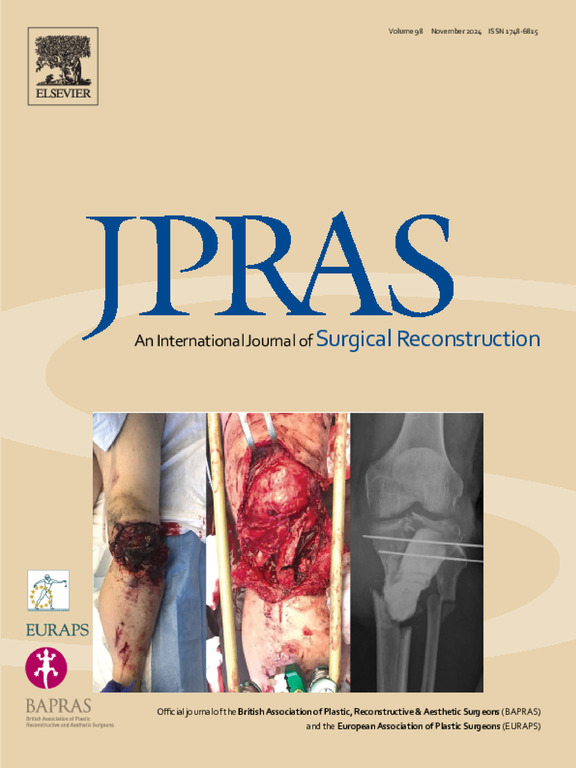First experience from 200 cases with a new breast tissue expander for multi-stage pre-pectoral breast reconstruction after mastectomy
IF 2
3区 医学
Q2 SURGERY
Journal of Plastic Reconstructive and Aesthetic Surgery
Pub Date : 2025-06-07
DOI:10.1016/j.bjps.2025.06.007
引用次数: 0
Abstract
Background
Breast cancer is the most common cancer globally, and mastectomy rates are increasing. Tissue expander-based breast reconstruction is used when direct-to-implant methods are unsuitable. A novel magnetic resonance imaging compatible breast tissue expander has recently been introduced. This study aims to evaluate its clinical use in pre-pectoral breast reconstruction and its complication profile.
Methods
A monocentric prospective cohort study included women undergoing expander-based breast reconstruction after mastectomy with the new tissue expander between August 2020 and October 2024. The expanders were placed in a pre-pectoral plane with optional use of acellular dermal matrices in selected cases. Demographic data, comorbidities, and surgical details were analyzed. Tissue expander-independent and -dependent complications were assessed.
Results
A total of 200 tissue expanders were implanted in 146 patients (92 unilateral, 54 bilateral). Major complications requiring expander replacement included infection (3.0%), partial necrosis of the mastectomy flap (2.5%), wound dehiscence (1.0%), hematoma (1.0%), and seroma (0.5%). Tissue expander rotation and/or flipping, as well as iatrogenic rupture, occurred in 2% and 3.5% of all cases. Definitive removal was required in ten cases, mainly due to mastectomy flap necrosis and wound dehiscence with or without expander exposure (2.5%), as well as infection (2.0%).
Discussion
The new breast tissue expander features a biocompatible surface that does not adhere to adjacent tissues and therefore needs fixation alongside the inframammary fold, particularly if used in the pre-pectoral plane, contributing to a low complication rate. While short-term results are promising, long-term follow-up on a larger scale is needed to confirm these outcomes.
对200例新型乳腺组织扩张器用于乳房切除术后多期胸前乳房重建的初步体会
乳腺癌是全球最常见的癌症,乳房切除术的比例正在上升。当直接植入方法不合适时,使用组织扩张器进行乳房重建。最近介绍了一种新型的磁共振成像兼容乳房组织扩张器。本研究旨在评估其在胸前乳房重建中的临床应用及其并发症。方法一项单中心前瞻性队列研究纳入了2020年8月至2024年10月期间在乳房切除术后使用新型组织扩张器进行基于扩张器的乳房重建的女性。扩张器被放置在胸前平面与选择性使用脱细胞真皮基质在选定的情况下。分析了人口统计资料、合并症和手术细节。评估组织扩张器非依赖性和依赖性并发症。结果146例患者共植入200个组织扩张器(单侧92例,双侧54例)。需要更换扩张器的主要并发症包括感染(3.0%)、乳房切除术皮瓣部分坏死(2.5%)、伤口裂开(1.0%)、血肿(1.0%)和血肿(0.5%)。组织扩张器旋转和/或翻转以及医源性破裂分别占所有病例的2%和3.5%。10例需要最终切除,主要是由于乳房切除术皮瓣坏死和伤口裂开,有或没有扩张器暴露(2.5%),以及感染(2.0%)。新的乳房组织扩张器具有生物相容性表面,不会粘附到邻近组织,因此需要在乳房下襞附近固定,特别是在胸前平面使用时,有助于降低并发症发生率。虽然短期结果令人鼓舞,但需要更大规模的长期随访来证实这些结果。
本文章由计算机程序翻译,如有差异,请以英文原文为准。
求助全文
约1分钟内获得全文
求助全文
来源期刊
CiteScore
3.10
自引率
11.10%
发文量
578
审稿时长
3.5 months
期刊介绍:
JPRAS An International Journal of Surgical Reconstruction is one of the world''s leading international journals, covering all the reconstructive and aesthetic aspects of plastic surgery.
The journal presents the latest surgical procedures with audit and outcome studies of new and established techniques in plastic surgery including: cleft lip and palate and other heads and neck surgery, hand surgery, lower limb trauma, burns, skin cancer, breast surgery and aesthetic surgery.

 求助内容:
求助内容: 应助结果提醒方式:
应助结果提醒方式:


